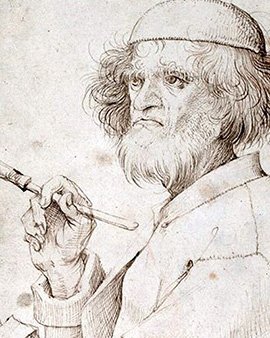Pieter Bruegel the Elder is one of the most important Dutch Renaissance painters of the 16th century and had a decisive influence on the subsequent Golden Age period. Little is known about his youth and family background. He probably began his training with the Antwerp artist Pieter Coecke van Aelst. Coecke was a respected and versatile artist with a large workshop. Bruegel stayed with him until the death of his master in 1550 and finished his apprenticeship. Then he himself was accepted as master in the Antwerp Lukas Guild. The following year Bruegel moved to Italy to continue his studies. Since Bruegel had the habit of signing and dating almost all his paintings, his journey and artistic development over the years can be traced very well. His itinerary was probably initially via France to Italy. In Italy, he travelled via Rome to Naples and then south to Calabria and probably also Sicily, as some of his drawings suggest. This journey lasted about two years until he went back to Rome in 1553. There he met the painter Giorgio Giulio Clovio. Clovio was strongly influenced by Michelangelo's work and was a close friend of El Greco. In Clovio's estate one later found various paintings and drawings by Bruegel. According to records, the two artists had also worked together on one of the works.
Bruegel lived and worked with Clovio in Rome for almost a year before returning to Antwerp. He found a job in the important copper workshop of Hieronymus Cook. After eight years Bruegel left Antwerp and moved to Brussels. There he married Mayken Coecke, the daughter of his former teacher. With the marriage and the move to Brussels, Bruegel's style and career path changed. Although he was still employed by Hieronymus Cook, the geographical distance probably meant that he produced fewer print copies and concentrated more on painting. Furthermore, he approached the work of his former master Pieter Coecke van Aelst technically and stylistically. For although Bruegel had learned from Coecke, his earlier works showed hardly any similarities or overlaps with the works of his master. His mother-in-law Maria Verhulst, a respected painter of her time, also influenced Bruegel. She taught him the technique of tempera. His preferred choice of motif, the mixture of allegorical and rural scenes, was also seen early on in the work of artists from Verhulst's home town of Melchen. Bruegel and his wife had two sons Pieter Brueghel der Jüngere and Jan Brueghel der Ältere, both of whom became well-known painters, and a daughter Marie, of whom little is known. Since Bruegel died very young and his children were too small, he probably had no direct influence on their artistic development. However, his older son later copied many of his works.
×





.jpg)
.jpg)
.jpg)
.jpg)
 - (MeisterDrucke-21204).jpg)
 - (MeisterDrucke-21204).jpg)
.jpg)
.jpg)
 - (MeisterDrucke-2593).jpg)
 - (MeisterDrucke-2593).jpg)
.jpg)
.jpg)
.jpg)
.jpg)
.jpg)
.jpg)
.jpg)
.jpg)
 - (MeisterDrucke-2603).jpg)
 - (MeisterDrucke-2603).jpg)
.jpg)
.jpg)
.jpg)
.jpg)
.jpg)
.jpg)
.jpg)
.jpg)
.jpg)
.jpg)
.jpg)
.jpg)
.jpg)
.jpg)
.jpg)
.jpg)
 1564 - (MeisterDrucke-60876).jpg)
 1564 - (MeisterDrucke-60876).jpg)
_t_-_(MeisterDrucke-1001956).jpg)
_t_-_(MeisterDrucke-1001956).jpg)
.jpg)
.jpg)
.jpg)
.jpg)
.jpg)
.jpg)
.jpg)
.jpg)
.jpg)
.jpg)
.jpg)
.jpg)
.jpg)
.jpg)
.jpg)
.jpg)
.jpg)
.jpg)
.jpg)
.jpg)
 - (MeisterDrucke-55305).jpg)
 - (MeisterDrucke-55305).jpg)
.jpg)
.jpg)
.jpg)
.jpg)
.jpg)
.jpg)
.jpg)
.jpg)
.jpg)
.jpg)
.jpg)
.jpg)
.jpg)
.jpg)
.jpg)
.jpg)
.jpg)
.jpg)
.jpg)
.jpg)
.jpg)
.jpg)
.jpg)
.jpg)
.jpg)
.jpg)
.jpg)
.jpg)
 published by Hieronymus Cock Antwerp c1560-65 - (MeisterDrucke-205945).jpg)
 published by Hieronymus Cock Antwerp c1560-65 - (MeisterDrucke-205945).jpg)
.jpg)
.jpg)
.jpg)
.jpg)
 - (MeisterDrucke-606335).jpg)
 - (MeisterDrucke-606335).jpg)
.jpg)
.jpg)
.jpg)
.jpg)
.jpg)
.jpg)
.jpg)
.jpg)
.jpg)
.jpg)
_-_(MeisterDrucke-898756).jpg)
_-_(MeisterDrucke-898756).jpg)
.jpg)
.jpg)
.jpg)
.jpg)
.jpg)
.jpg)
.jpg)
.jpg)
.jpg)
.jpg)
 - (MeisterDrucke-38317).jpg)
 - (MeisterDrucke-38317).jpg)
.jpg)
.jpg)
 - (MeisterDrucke-69845).jpg)
 - (MeisterDrucke-69845).jpg)
.jpg)
.jpg)
 - (MeisterDrucke-137859).jpg)
 - (MeisterDrucke-137859).jpg)
.jpg)
.jpg)
 - (MeisterDrucke-219858).jpg)
 - (MeisterDrucke-219858).jpg)
.jpg)
.jpg)
_Painting_by_Pi_-_(MeisterDrucke-971004).jpg)
_Painting_by_Pi_-_(MeisterDrucke-971004).jpg)
.jpg)
.jpg)
.jpg)
.jpg)
.jpg)
.jpg)
.jpg)
.jpg)
 - (MeisterDrucke-74032).jpg)
 - (MeisterDrucke-74032).jpg)
.jpg)
.jpg)
 detail of bottom section showing various games 1560 (detail of 68945) - (MeisterDrucke-87000).jpg)
 detail of bottom section showing various games 1560 (detail of 68945) - (MeisterDrucke-87000).jpg)
 1557 - (MeisterDrucke-2592).jpg)
 1557 - (MeisterDrucke-2592).jpg)
.jpg)
.jpg)
.jpg)
.jpg)
_Painting_by_Pieter_Bruegel_the_-_(MeisterDrucke-1002701).jpg)
_Painting_by_Pieter_Bruegel_the_-_(MeisterDrucke-1002701).jpg)
 - (MeisterDrucke-361131).jpg)
 - (MeisterDrucke-361131).jpg)
.jpg)
.jpg)
_Ec_-_(MeisterDrucke-1002892).jpg)
_Ec_-_(MeisterDrucke-1002892).jpg)
.jpg)
.jpg)
.jpg)
.jpg)
_-_(MeisterDrucke-974694).jpg)
_-_(MeisterDrucke-974694).jpg)
.jpg)
.jpg)
.jpg)
.jpg)
_Painting_by_Pieter_Bruegel_(or_Br_-_(MeisterDrucke-1021977).jpg)
_Painting_by_Pieter_Bruegel_(or_Br_-_(MeisterDrucke-1021977).jpg)
.jpg)
.jpg)
_-_(MeisterDrucke-875795).jpg)
_-_(MeisterDrucke-875795).jpg)
.jpg)
.jpg)
.jpg)
.jpg)
.jpg)
.jpg)
.jpg)
.jpg)
 - (MeisterDrucke-84934).jpg)
 - (MeisterDrucke-84934).jpg)
.jpg)
.jpg)
 - (MeisterDrucke-109530).jpg)
 - (MeisterDrucke-109530).jpg)
.jpg)
.jpg)
.jpg)
.jpg)






